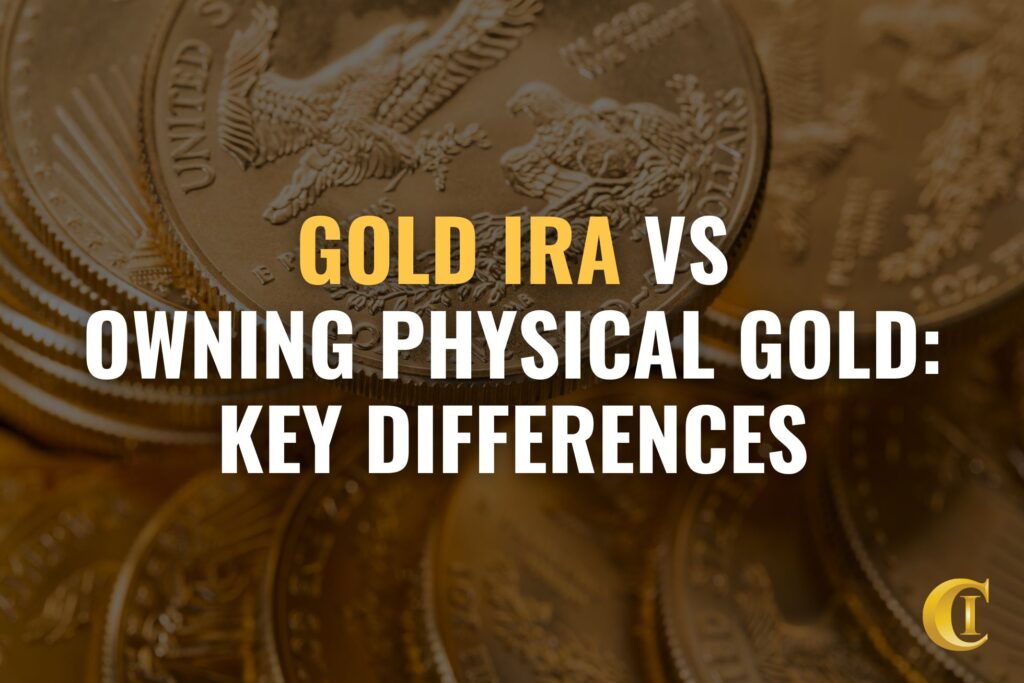Gold IRA vs Physical Gold Bars and Coins
The article compares two ways to invest in gold: gold IRAs and physical gold (bars and coins), outlining their differences, benefits, and drawbacks to help investors decide which suits their financial goals during economic uncertainty.

Written by Rick Erhart
Rick Erhart is an experienced precious metals professional with more than ten years in the field. He earned a degree in finance and is widely regarded as a specialist in self-directed IRAs.
In recent years, the economy has navigated turbulent waters, grappling with persistent inflation, frequent Federal Reserve rate increases, and a housing market that’s tough to forecast. Experts share countless predictions, yet the economic outlook for the near future remains unclear.
Given these uncertainties, it’s a prudent moment to reassess your financial roadmap, particularly your investments. During periods of economic volatility, many investors turn to precious metals like gold, drawn by their unique benefits.
If you want to learn more about gold IRAs and investing in physical gold for retirement, be sure to download a free gold IRA kit.
It contains key information on the benefits, steps, and possible disadvantages of including physical gold in your retirement portfolio.

You can invest in gold through various methods, with two popular options being gold Individual Retirement Accounts (IRAs) and tangible gold assets, like coins or bars. If you’re thinking about including gold in your portfolio, how do you choose the approach that’s right for you?
Gold IRA vs Physical Gold: Key Differences
Here’s a clear breakdown of how investing in a gold IRA compares to owning physical gold, highlighting the main distinctions to help you decide.
Control: Physical gold gives you complete control, allowing you to choose from a wide variety of gold types, such as coins or bars. With a gold IRA, your investment options are limited to IRS-approved, coins and bars of highest purity. IRS allows specific gold coins and bullion of 99.5% purity, and the custodian oversees the assets.
Liquidity: Physical gold typically offers greater liquidity, because it can be sold quickly in an active market whenever you choose. In contrast, accessing funds from a gold IRA may involve slight delays due to custodian processes or penalties for early withdrawals before a certain age, making it less flexible.
Tax Implications: Gold IRAs provide tax advantages, such as tax-deferred growth and potential deductions on contributions, making them appealing for retirement planning. Physical gold offers no tax benefits, and profits from sales are taxed as collectibles at a rate of up to 28%. This is higher than standard capital gains taxes.
Storage: When you own physical gold, you’re responsible for keeping it secure, whether in a home safe or a bank’s safe deposit box. A gold IRA eliminates this burden. Gold in a gold IRA is stored in a secure, IRS-approved depository. It is managed by a custodian, ensuring professional handling and safety.
Fees: The cost structures differ significantly. Physical gold usually involves a one-time purchase cost, though storage or insurance may add expenses. Gold IRAs, however, come with multiple fees, including setup charges, annual maintenance, storage, and others, which can increase the overall cost of the investment over time.
How Does a Gold IRA Work?
A gold individual retirement account functions similarly to a traditional or Roth IRA. However, instead of paper assets, your funds are invested in physical metals. To begin, you must open a self-directed IRA with a custodian approved by federal or state authorities to manage such accounts. The custodian oversees and safeguards your assets but does not offer investment advice or select dealers for you. They may, however, provide a list of trusted gold IRA companies.
Traditional IRAs focus on stocks, bonds, and mutual funds. A gold IRA is a self-directed IRA that offers you exposure to physical gold. This type of account allows you to hold physical precious metals like gold, silver, platinum, or palladium.
All gold purchases for the IRA must be made directly through the account, not with personal funds. You’ll typically place orders via the custodian’s platform or a designated broker network, which often involves transaction fees or commissions. Additionally, the precious metals IRA company usually arranges secure storage for your metals in a vault, which incurs fees, either a flat rate or a percentage of the metal’s value.
Read our guide on the best gold IRAs to explore the top-rated companies to work with, key factors to consider, and gimmicks to avoid.
Choosing the right gold IRA company requires careful research. Key factors to consider include the company’s reputation, regulatory compliance, fee structures, storage solutions, and customer service quality. Thorough due diligence is essential to safeguard your retirement savings and ensure a smooth investment experience.
How to Invest in Physical Gold?
Buying physical gold typically means acquiring gold in the form of bars or coins. The cost includes the market price per ounce plus a small premium charged by the seller. Gold bars are available in sizes from one gram to 400 ounces and often have a lower markup, because they aren’t minted like coins. Wealthy investors may find larger bars more practical than managing multiple coins.
Gold coins, on the other hand, are widely popular and easy to transport. This makes them more convenient for private sales.
Well-known options include: American Gold Eagle, Canadian Maple Leaf, South African Krugerrand. Sizes typically range from one-tenth to one ounce. Smaller coins tend to carry a higher per-ounce premium. You can purchase these from local dealers or reputable online retailers.

Coins fall into two categories: bullion and numismatic. Bullion coins derive their value from their gold content. Numismatic coins, on the other hand, are valued for their rarity and can be far more expensive. For example, certain pre-1933 U.S. gold coins are now scarce, boosting their collectible worth significantly.
While gold jewelry is another way to own gold, particularly in some global markets, it’s not a strong investment choice. Most U.S. jewelry is 14-karat, which means it’s roughly 60% of gold and 40% of other metals. High craftsmanship costs further reduce its investment value. For instance, a $1,000 necklace might contain only $100 worth of gold.
Guidelines, Taxes, and IRS Rules
Here is our comprehensive side-by-side analysis of the rules, tax benefits, and requirements for gold IRAs compared to investing in physical precious metals.
Gold IRA
Tax-Deferred Earnings: Any increase in the value of gold held within your IRA remains untaxed as long as it stays in the account. This can lead to significant savings over time. For example, if you buy gold worth $5,000 in your IRA and later sell it for $7,000, the $2,000 profit isn’t taxed until you withdraw the funds. In a non-IRA account, you’d owe capital gains tax on that profit right away.
Deductible Contributions: With a traditional IRA, you may be able to deduct your contributions from your taxable income, depending on your income level. This lowers your tax bill for the year. For instance, if you’re in the 24% tax bracket and contribute $5,000 to your IRA, you could save $1,200 on your taxes ($6,000 multiplied by 0.24).
Tax Flexibility: Taxes on a traditional IRA are paid when you withdraw funds, often during retirement. If you expect to be in a lower tax bracket then, you could save money. For example, if you’re in the 32% bracket now but drop to 22% in retirement, you’d pay 10% less tax on withdrawals.
IRS Regulations: The IRS prohibits holding collectibles in an IRA, but certain gold coins and bullion are allowed. However, some gold items are classified as collectibles and are not permitted. Navigating these rules can be tricky since the IRS doesn’t provide a clear list of approved gold types.
Physical Gold
Tax Treatment: The IRS views physical gold, silver, platinum, palladium, and titanium, as capital assets, specifically collectibles. When you sell physical gold (whether coins, bars, or ingots) the profit is taxed at a 28% collectibles rate. This is higher than the typical capital gains rate for assets like gold stocks.
Reporting Requirements: Selling physical gold comes with strict IRS reporting rules. As an investor, you’re responsible for following these guidelines, which may include immediate reporting for certain gold sales. Compliance is critical to avoid penalties.
Liquidity and Control Over Investments
| Owning a Gold IRA | Owning Physical Gold |
|---|---|
| With a gold IRA, your gold is held by a custodian, unlike physical gold, which you can access directly. If an urgent need arises, retrieving your gold requires going through the custodian’s procedures, which can take time and add complexity. This lack of immediate control makes gold IRAs less flexible in emergencies compared to owning gold outright. | Physical gold offers strong liquidity, meaning it can typically be sold quickly due to a consistently active market. Whether you hold coins, bars, or ingots, you can often find a buyer without much delay. In contrast, accessing funds from a gold IRA may involve restrictions or penalties, such as fees for withdrawing before a specific age, which can slow down the process. |
Costs and Fees
Storing physical gold securely can be challenging, unless you have a high-quality home safe or rent a bank safe deposit box. Many investors choose pooled accounts. This means that gold is kept in a vault and you’re assigned either a specific bar or coin (allocated) or a general share of gold (unallocated).
Allocated accounts offer clear ownership but include storage and insurance costs. Unallocated accounts may reduce fees, but if the storage company faces bankruptcy, your gold could be at risk from creditors.
Costs of Physical Gold Ownership
- Premium above the spot price (typically 3%–10%, depending on the gold type)
- Sales tax in certain regions
- Storage expenses (home safe, bank box, or private vault)
- Insurance costs
- Dealer spreads when buying or selling
Opening and maintaining a gold IRA involves fees at every stage, from buying the gold to storing and eventually selling it. These costs increase the amount your investment needs to grow to break even.
Custodians charge varying fees. Some use a flat rate, while others base it on the value of your gold. Gold IRAs often have higher upkeep costs than other IRAs because of the physical asset involved.
Beyond standard IRA fees, you may face additional charges like brokerage fees, shipping costs, storage, insurance, markups on purchases, and fees to close the account.
Costs of Opening and Maintaining a Gold IRA
- Initial setup fees ($50–$150)
- Yearly maintenance fees ($75–$300)
- Storage fees (usually 0.5%–1% of asset value per year)
- Custodian charges
- Buy/sell spreads when purchasing or liquidating gold
Safety and Security
| Owning a Gold IRA | Owning Physical Gold |
|---|---|
| Gold in a gold IRA is kept in IRS-approved depositories, which use advanced vaults and robust security systems, including insurance for added protection. However, there are risks tied to the custodian or depository, such as mismanagement, fraud, or financial failure. While uncommon, these possibilities should not be overlooked. | Storing gold at home may seem convenient, but it’s risky, especially for larger amounts. Gold kept at home is vulnerable to theft, loss, or damage from events like fires or floods. Renting a safe deposit box at a bank is a safer choice, but it’s not foolproof. Bank issues or, in rare cases, government seizure could put your gold at risk. |
Aligning with Your Investment Goals
Your financial priorities should guide your choice between a gold IRA and physical gold ownership.
A gold IRA is ideal for those planning for retirement over the long term. If you prioritize tax benefits and secure storage over quick access, it is more suitable for you. These accounts are most effective within a broader retirement plan rather than as a short-term investment.

Physical gold, on the other hand, attracts investors who want full control of their assets. Physical gold investors often worry about risks tied to financial markets and value the ability to access their gold at any time. For many, owning physical metals offers reassurance during times of economic uncertainty or market fluctuations.
Choosing Between a Gold IRA and Physical Gold
The right gold investment depends on your unique financial goals and circumstances.
Consider opening a gold IRA if:
- You value tax benefits and want to reduce your tax burden.
- Your focus is on building wealth for retirement.
- Secure, professional storage provides confidence.
- You prefer minimal involvement in managing security.
- You have retirement savings ready to transfer into an IRA.
Consider investing in physical gold if:
- Having full control over your assets is essential.
- You want the ability to access your gold quickly.
- You’re wary of risks within the financial system.
- You want to avoid ongoing fees or reliance on custodians.
- You have a safe, reliable way to store your gold.
Advantages of Investing in Physical Gold
Gold offers several distinct benefits that make it an attractive option, especially in times of economic uncertainty.
Potential for Long-Term Appreciation
Gold has shown strong growth over time, making it a compelling choice for investors. For example, gold’s value has surpassed the performance of Warren Buffett’s Berkshire Hathaway by 133% since 2000.
From 1971 (post-Bretton Woods) to June 2025, gold’s price rose from $35 per ounce to approximately $3,329 per ounce, a compounded annual growth rate (CAGR) of about 8.74%.
In contrast, the purchasing power of the U.S. dollar declined significantly due to inflation. $1 in 1971 is equivalent to roughly $7.78 in 2025. This highlights gold’s ability to not only preserve but substantially grow wealth compared to cash.
Stability in Economic Downturns
Gold’s price doesn’t always move in opposition to the stock market. However, it has consistently proven to be a safe haven asset during periods of financial turmoil.
Control Through Physical Ownership
Owning physical gold provides a unique sense of security. Unlike stocks or bonds, which rely on third parties, physical gold is fully under your control. This direct ownership can bring peace of mind, knowing your investment is tangible and independent of external institutions.
Downsides of Investing in Physical Gold
While physical gold may appeal as a tangible asset or a safeguard during economic uncertainty, it comes with several obstacles that investors should carefully consider.
Storage Expenses
If you don’t have an expensive home safe or a bank safe deposit box, safeguarding physical gold can be a significant challenge. Alternatively, some investors use pooled accounts, where gold is stored in a vault and you’re assigned either a specific bar or coin (allocated) or a share of gold (unallocated).
Allocated accounts ensure direct ownership but involve storage and insurance costs. Unallocated accounts may lower expenses, but if the storage company goes bankrupt, your gold could be claimed by creditors.
Limited Practicality in Crises
Gold is often seen as a reliable store of value. However, its usefulness during a severe economic collapse is uncertain. Ask yourself: would someone trade food, supplies, or other vital goods for gold in a crisis? The answer isn’t always clear, and gold’s real-world utility may be limited in extreme scenarios.
Premiums on Purchase
When buying physical gold, you typically pay a markup above the market price, increasing the cost of ownership. This premium can lead to larger losses if gold’s value declines, making it a riskier investment than it might appear.
Tax Disadvantages
The IRS classifies physical gold as a collectible, which is treated as a capital asset.
When you sell gold, the profit is taxed at a 28% rate, which is higher than the standard capital gains tax applied to assets like gold-related stocks.
Reporting Obligations
Selling physical gold requires strict adherence to IRS reporting rules. As an investor, you’re responsible for complying with all IRS regulations. Failing to meet these requirements could lead to penalties.

Advantages of Investing in a Gold IRA
Holding gold in an Individual Retirement Account (IRA) offers several tax advantages that can enhance your long-term financial strategy.
Growth Without Immediate Taxes
Any increase in the value of gold held in your IRA remains untaxed as long as the funds stay in the account. This tax deferral can lead to significant savings over time. If you invest $5,000 in gold through your IRA and later sell it for $7,000, the $2,000 profit isn’t taxed until you withdraw the money. In a regular investment account, you’d owe capital gains tax on that profit immediately after the sale.
Deductible Contributions
With a traditional IRA, you may be able to deduct your contributions from your taxable income, depending on your income level. This lowers your tax liability for the year you contribute.
For instance, if you’re in the 24% tax bracket and add $6,000 to your IRA, you could reduce your taxes by $1,440 ($6,000 × 0.24), providing immediate tax relief.
Tax Rate Advantages in Retirement
Taxes on a traditional IRA are deferred until you withdraw funds, typically during retirement. If you expect to be in a lower tax bracket at that time, you could pay less tax on your withdrawals.
For example, if you’re currently in the 32% tax bracket but anticipate being in the 22% bracket in retirement, you’d save 10% on the taxes applied to the withdrawn amounts.
Downsides of Investing in a Gold IRA
While a gold IRA can diversify your retirement savings, it comes with complexities and costs that require careful evaluation before investing. There are some cons to a gold IRA that you should consider to gain a complete picture.
Dependence on Custodians
Unlike physical gold that you can access directly, gold in a gold IRA is held by a custodian. If you need your gold urgently, you must follow the custodian’s procedures, which can delay access and add complications, introducing risks tied to the custodian’s reliability.
Setting Up a Specialized IRA
A gold IRA requires a self-directed IRA, which cannot be managed by standard firms like Fidelity or Charles Schwab. You’ll need to find a custodian specializing in gold IRAs, such as Equity Trust Company or STRATA Trust. Selecting a trustworthy custodian demands thorough research to ensure they meet your needs.
Navigating IRS Regulations
The IRS prohibits collectibles in IRAs, but permits specific gold coins and bullion. Other gold items may be classified as collectibles, violating IRS rules. Determining which types are allowed can be difficult, as the IRS does not provide a clear list of approved or restricted gold.
Higher Costs and Fees
Establishing and maintaining a gold IRA involves multiple expenses, including purchasing, storing, and selling the gold. These costs increase the amount your investment must earn to break even. Custodians charge varying fees. Some charge flat fees, others based on the gold’s value.
Compared to other IRAs, gold IRAs often have higher maintenance costs due to the physical asset, with additional charges like brokerage fees, shipping, storage, insurance, purchase markups, and account closure fees.
Liquidity Challenges
Selling gold can be difficult, especially in large quantities, without accepting a lower price. Gold prices can also be volatile, fluctuating significantly. When IRA holders reach age 73 and face required minimum distributions, they may be forced to sell at an unfavorable price, potentially reducing their returns.
FAQs
How is gold taxed in a gold IRA?
Investing in a gold IRA versus holding physical gold involves distinct tax considerations. When you sell physical gold for a profit, you typically face capital gains tax, which can reach up to 28% depending on your circumstances.
In contrast, a gold IRA offers tax advantages if you adhere to IRS regulations. Contributions and growth within the account are generally tax-deferred, and in some cases, withdrawals can be tax-free. Once you reach age 59½, any distributions are taxed as ordinary income based on your tax bracket at the time.
Be cautious about early withdrawals. Taking funds out before age 59½ may trigger a penalty, typically 10%, plus income taxes on the amount withdrawn. Both physical gold and gold IRAs provide ways to invest in gold, but understanding their tax differences is key to making an informed choice.
Does the IRS know when you buy physical gold?
The IRS doesn’t automatically receive notifications for every gold purchase, but specific transactions trigger reporting requirements for dealers. Additionally, certain cash payments and sales of gold may involve IRS reporting.
Here’s a clear breakdown:
- Dealer Reporting Obligations: When dealers sell gold coins, bullion, or jewelry in transactions valued over $600, they must report these sales to the IRS. This ensures the government tracks significant precious metal transactions.
- Cash Transaction Limits: If you use cash to buy gold and the payment is $10,000 or more, the dealer is required to report the transaction to the IRS. This rule applies to single or related cash payments meeting or exceeding this threshold.
- Reporting Gold Sales: When you sell gold, dealers may report the transaction to the IRS, particularly if the sale exceeds $600 or involves a substantial amount of gold. This helps the IRS monitor potential taxable events.
- Tax Considerations: Selling gold at a profit typically requires you to pay capital gains tax. The tax is calculated based on the difference between your purchase price and the sale price.
Am I allowed to store gold IRA assets at home?
You might think a gold IRA allows you to keep gold coins or bars at home for easy access. However, this isn’t permitted. The IRS classifies gold in a Self-Directed IRA as a retirement asset, not a personal investment.
As a result, all precious metals in a gold IRA must be stored in an IRS-approved, insured depository to comply with regulations.
So, what exactly is an approved depository, and how does it function when you want to add gold to your IRA? With gold prices attracting investor interest, you may want to increase your holdings. Here’s a simple explanation:
An approved depository is a secure, IRS-compliant facility that specializes in storing precious metals for IRAs. These depositories ensure your gold is safely held, insured, and properly documented.
When you purchase gold for your IRA, the metal is delivered directly to the depository, not to you. This maintains the tax-advantaged status of your IRA.
Choosing a depository is a key step in managing a gold IRA, as it guarantees compliance and protects your investment.
Conclusion
Deciding between a gold IRA and physical gold hinges on your financial goals, risk tolerance, and investment timeline.
- A gold IRA offers tax advantages, professional storage, and a structured approach ideal for long-term retirement planning. However, it comes with higher fees, limited flexibility, and reliance on custodians.
- Physical gold provides immediate control, high liquidity, and independence from financial institutions. Yet, it carries storage challenges, tax disadvantages, and no tax-deferred growth.
In today’s uncertain economic climate, both options can diversify your portfolio and hedge against volatility. However, neither opening a gold IRA nor buying physical gold is a one-size-fits-all solution. Evaluate your priorities, because this is the only way to know what is best for you.
Ultimately, you should choose the path that aligns with your vision for financial stability. Go for a gold IRA if you want tax efficiency and security. Choose physical precious metals for accessibility and autonomy. The decision is yours!
